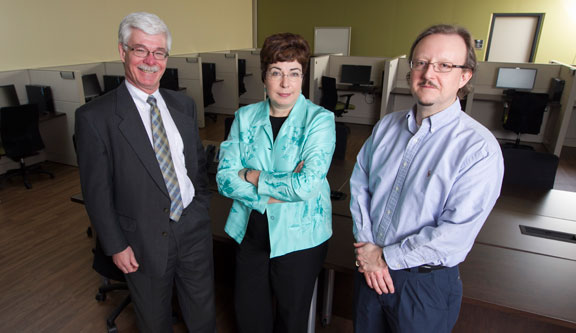Disciplines come together to investigate decision-making
A trio of researchers at the new Experimental Decision Laboratory is striving to better understand how individuals, groups and even nations make decisions about innovation that affect health care, food, business, and even personal lives.
By Colleen MacPherson "The socio-economic world is inextricably linked to the political and policy space," said Peter Phillips, professor with the Johnson-Shoyama Graduate School of Public Policy, explaining that decisions are made at all stages of innovation, from early development and evaluation, to public approval and acceptance.
"The socio-economic world is inextricably linked to the political and policy space," said Peter Phillips, professor with the Johnson-Shoyama Graduate School of Public Policy, explaining that decisions are made at all stages of innovation, from early development and evaluation, to public approval and acceptance.
The lab is unusual in that it combines research in three disciplines – public policy, psychology and economics. This is a powerful combination, said Phillips, who co-leads the lab with James Nolan, associate professor in the Department of Bioresource Policy, Business and Economics, and Valerie Thompson, professor and head of the Department of Psychology.
The facility, located in the Social Sciences Research Laboratories in the Arts Building, was created with $377,000 from the Canada Foundation for Innovation and Saskatchewan's Innovation and Science Fund.
"Being able to test for the full array of effects, separately, and then jointly, will help us understand more completely the challenges of generating optimal innovation," Phillips said.
Phillips explained that the three disciplines are all interested in decision-making, but from different angles. Psychologists are often interested in cognitive capacity, economists in transactions and exchanges, and policy analysts in how individual decisions affect others.
In particular, the researchers will be looking at how people's biases affect decision-making in areas like expert-lay relationships (as in health care), markets for new products and regulation of new technologies and innovative products.
Phillips cites research that shows that all decisions will be biased, but context is everything. In general, the more comfortable people are, the less risk they will accept.
"If people start from a happy place, people are risk averse; if they start from a point of crisis, they can be induced to take a lot more risk," he said. "That generates conflict in decision systems."
Complexity is also a factor. For example, regulators and politicians, when faced with ever-more complicated evidence and decision criteria, may simply opt to "go with their gut.
"This can lead to too many good ideas being rejected, while at the same time accepting too many high-risk options," he said.
The lab features computer cubicles, where participants are isolated and given various tasks to complete. Video captures non-verbal cues like posture and how participants' eyes move as they make decisions.
He said a mobile version of the lab will allow research to move into the field, "to doctor's offices, to farms, to professional conferences and inside firms, NGOs and government agencies" to see if real-world results match those from the main lab.
Finishing touches on the lab are being completed, and the researchers are designing experiments to be conducted once it opens this summer.
"Ultimately, we anticipate we can work with key partners in industry, government and civil society to help them construct more effective ‘choice architecture' to improve their own decision making."

